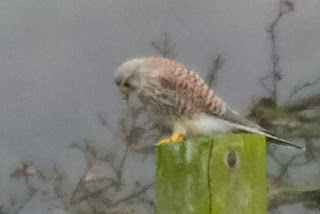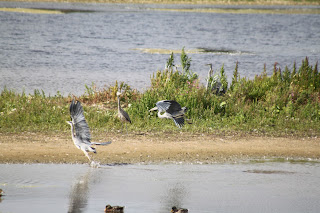28th 6 longtailted tits in the garden flitting around, 2 goldfinch, 2 blue tits, 2 great tits and a cole tit. It is sunny ans warm.
At the nature reserve we see swans, lapwings, cormorants, herons, gulls, mallards, starlings and a snipe.
Snipe
" So lonely his plaint by the motionless reed,
It sounds like an omen or tale of the dead." ...James Hogg
Snipe ( Gallinago gallinago ) A secretive bird that fly's in a zig zag motion in loose flocks called "wisps". Breeds in more land and bogs or low-lying marshes. Eats from wet ground worms and insects. Lays 4 eggs.
30th September ends with another sunny hot day of 28 deg - a few days of an Indian summer.
Sunday 9 October 2011
September 2011 part 4
27th After hearing about the problems Horse Chestnut Trees are having throughout the country I went to visit my old childhood haunts "conker island" and "the green" to see for myself. Sadly there is evidence of the problem here. Leaves have turned prematurely brown and the pattern on the leaves show the pattern of the lavae eating the leaves.
Lots of conkers lay on the ground so maybe the game of "conkers" is dying out as a children's game anyway as in my day and even my children's day they would have all been collected up.
Horse Chestnut tree (Nesculus hippocastarium) native to the Balkans it has naturalised in Europe. Can grow up to 30m. Fruit is green globular and spiny splitting when ripe to reveal brown shiny seeds (conkers). Sadly they are under threat by the leaf minor moth whose larvae eats the leaves. There is one small hope as the blue and great tit like to eat the caterpillars.
Lots of conkers lay on the ground so maybe the game of "conkers" is dying out as a children's game anyway as in my day and even my children's day they would have all been collected up.
Horse Chestnut tree (Nesculus hippocastarium) native to the Balkans it has naturalised in Europe. Can grow up to 30m. Fruit is green globular and spiny splitting when ripe to reveal brown shiny seeds (conkers). Sadly they are under threat by the leaf minor moth whose larvae eats the leaves. There is one small hope as the blue and great tit like to eat the caterpillars.
September 2011 part 3
23rd Home farm Hereford . The Autumn Equinox. - The same amount of day as night.
Sunny but windy. The swallows and pied wagtails are still here. We have beautiful views over the countryside from this pitch.
24th Watching the pied wagtails while eating my breakfast I wonder if they compensate for the wind or just fly like crazy against it? I think as some are blown off course they just fly like crazy sometimes winning and sometimes not. On our walk we see loads of blackberries, hips on the hawthorn and flowers on the ivy, where flies are gathering a vital last source of nectar.
Blackberry jam
Put 900g of blackberries into a large pan
Add 50ml water, 1 1/2 tsp lemon juice and bring to the boil.
Simmer for 15 mins until friut is soft,
Add 900g of golden granulated sugar.
Stir over a low heat until sugar has dissolved.
Raise heat bring to a rolloing boil for 10-12 mins
DO NOT STIR until setting point of 105 deg C is reached.
Remove from heat skim off scum.
Stir in knob of butter leave for 15mins to settle.
Pour into sterilized jars, label, seal and enjoy.
from Good Food Mag 2009.
25th 2 pairs of buzzards in one direction and a group of 8 in another in the skies above us stunning.
While packing up to come home Andy spots a hen harrier in the sky and calls me to look. It stays for quite a while scanning the fields around the van we dont mind the interuption.
Hen harrier ( Circus cyaneus) Usually seen alone but will gather in winter roots. Lives in heather moors, conifer plantations, lowland farms, river valleys and coastal marshes. Feeds on small birds, voles mice and rabbits. Lays 4-5 eggs.
Sunny but windy. The swallows and pied wagtails are still here. We have beautiful views over the countryside from this pitch.
24th Watching the pied wagtails while eating my breakfast I wonder if they compensate for the wind or just fly like crazy against it? I think as some are blown off course they just fly like crazy sometimes winning and sometimes not. On our walk we see loads of blackberries, hips on the hawthorn and flowers on the ivy, where flies are gathering a vital last source of nectar.
Blackberry jam
Put 900g of blackberries into a large pan
Add 50ml water, 1 1/2 tsp lemon juice and bring to the boil.
Simmer for 15 mins until friut is soft,
Add 900g of golden granulated sugar.
Stir over a low heat until sugar has dissolved.
Raise heat bring to a rolloing boil for 10-12 mins
DO NOT STIR until setting point of 105 deg C is reached.
Remove from heat skim off scum.
Stir in knob of butter leave for 15mins to settle.
Pour into sterilized jars, label, seal and enjoy.
from Good Food Mag 2009.
25th 2 pairs of buzzards in one direction and a group of 8 in another in the skies above us stunning.
While packing up to come home Andy spots a hen harrier in the sky and calls me to look. It stays for quite a while scanning the fields around the van we dont mind the interuption.
Hen harrier ( Circus cyaneus) Usually seen alone but will gather in winter roots. Lives in heather moors, conifer plantations, lowland farms, river valleys and coastal marshes. Feeds on small birds, voles mice and rabbits. Lays 4-5 eggs.
September 2011 part 2
9th -12th Home farm Hereford
Once again we are at the caravan. Strong winds all weekend as hurricane Kattia blows through. I'm glad to see that the swallows are still here but they are having trouble flying in the wind. The pied wagtails are hunting on the ground around the vans. Starting at one end of the field they work their way up towards the oncoming winds waiting for the flies that it brings them. The wind catches them as they take flight and swoops them away.
Back home the hedgehog is still visiting I'm hoping she is big enough to survive the winter to come.
17th Travelling to see friends we see a kestrel hovering by the roadside hunting on the verges.
My manners are tearing off heads... Ted Hughes
Kestrel (Falco tinnunculus) Usually seen alone hunting by either hovering in the wind or from a perch. Lives in towns and rough grassland. Feeds on small mammals- voles, shrews, mice small birds, beetles and other insects. Lays 4-5 eggs.
Once again we are at the caravan. Strong winds all weekend as hurricane Kattia blows through. I'm glad to see that the swallows are still here but they are having trouble flying in the wind. The pied wagtails are hunting on the ground around the vans. Starting at one end of the field they work their way up towards the oncoming winds waiting for the flies that it brings them. The wind catches them as they take flight and swoops them away.
Back home the hedgehog is still visiting I'm hoping she is big enough to survive the winter to come.
17th Travelling to see friends we see a kestrel hovering by the roadside hunting on the verges.
My feet are locked upon rough bark.
It took the whole of Creation
To produce my foot, my each feather.
Now I hold creation in my foot.
Or fly up, and resolve it all slowly-
I kill where I please because its all mine.
There is no sophistry in my body;My manners are tearing off heads... Ted Hughes
Kestrel (Falco tinnunculus) Usually seen alone hunting by either hovering in the wind or from a perch. Lives in towns and rough grassland. Feeds on small mammals- voles, shrews, mice small birds, beetles and other insects. Lays 4-5 eggs.
Monday 3 October 2011
September 2011 part 1
September "Best I love September's yellow,
Morns of dew-strung gossamer,
Thoughful days without a stir,
Rooky clamours, brazen leaves,
Stubble dotted o'er with sheaves -
More than Spring's bright uncontrol
, Suit the Autumn of my soul." ...Alex Smith
The first week has been mixed weather wise - some sunny days others mixed with rain. On our first trip to the local nature reserve we see a rise in the number of swans on the lake, a large number of geese, starlings and various gulls, lapwings and a group of 7 young heron's on one of the islands and others on the far side of the lake.
A group of herons is called a "scattering, a siege or a sedge."
Something scares the flock and they rise to the air as one but still within their own distinctive groups proving I suppose that "birds of a feather flock together".
We also saw lots of common darter dragonflies.
Common Darter (sympetrum strolatum)
middle sized and restless regularly perching on bank side vegetation or on plain ground to gain warmth.
We also see this grasshopper but I'm having trouble identifying it.
Later a walk along the river shows a huge growth in the Himalayan balsam, a small fire has taken down some of the grass but it is already starting to regrow. A pigeon flies over and apart from a pair of speckled wood butterflies there is little else.
Morns of dew-strung gossamer,
Thoughful days without a stir,
Rooky clamours, brazen leaves,
Stubble dotted o'er with sheaves -
More than Spring's bright uncontrol
, Suit the Autumn of my soul." ...Alex Smith
The first week has been mixed weather wise - some sunny days others mixed with rain. On our first trip to the local nature reserve we see a rise in the number of swans on the lake, a large number of geese, starlings and various gulls, lapwings and a group of 7 young heron's on one of the islands and others on the far side of the lake.
A group of herons is called a "scattering, a siege or a sedge."
Something scares the flock and they rise to the air as one but still within their own distinctive groups proving I suppose that "birds of a feather flock together".
We also saw lots of common darter dragonflies.
Common Darter (sympetrum strolatum)
middle sized and restless regularly perching on bank side vegetation or on plain ground to gain warmth.
We also see this grasshopper but I'm having trouble identifying it.
Later a walk along the river shows a huge growth in the Himalayan balsam, a small fire has taken down some of the grass but it is already starting to regrow. A pigeon flies over and apart from a pair of speckled wood butterflies there is little else.
Subscribe to:
Posts (Atom)








